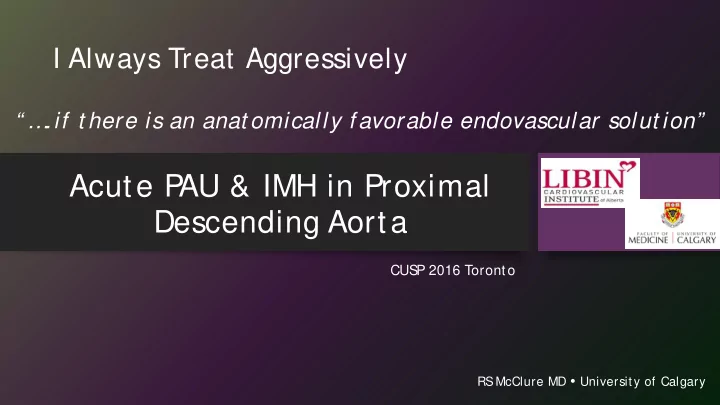

I Always Treat Aggressively “ … .if t here is an anat omically favorable endovascular solut ion” Acute P AU & IMH in Proximal Descending Aorta CUS P 2016 Toronto McClure MD University of Calgary RS
Penetrating Atherosclerotic Ulcers (P AU) & Intramural Hematomas (IMH) • Entities within the spectrum of Acute Aortic S yndrome continuum • IMH – bleed within the media of the aortic wall in the absence of a clearly defined primary intimal tear site • P AU –An ulcerated atherosclerotic lesion that penetrates the internal elastic lamina into the media • Main obj ective of IMH & P AU treatment is to prevent progression to classic aortic dissection and/ or aortic rupture
Acute P AU or IMH S o What Are We Really Talking About? • P AU or IMH present with symptoms and impending rupture or rupture - This is acute process & patient unstable = Aggressively Treat! • P AU or IMH found incidentally in asymptomatic patient - This is chronic process & patient stable = Conservatively manage! • P AU or IMH presents with symptoms but clinically settles = ? ? ? ? ?
S o What Do We Really Know? • Pat ient s are older wit h more co-morbidit ies At herosclerot ic burden / HTN / S mokers / Male • Nat ural hist ory for IMH & P AU not fully underst ood or properly defined Dat a quit e limit ed - Case report s / S mall series / Ret rospect ive - Varied lesion locat ions combined int o conj oined analyses - Varied pat ient present at ions combined int o conj oined analyses - Conflict ing experiences → Asia (indolent ) vs. t he West • Neit her pat hology is st at ic Each rat her unpredict able → unsuspect ing progression brings serious consequences • TEV AR is a low impact and high yield in t he right anat omy
AGGRES S IVELY TREAT ALL ACUTE P AU AND IMH IN THE PROXIMAL DES CENDING AORTA? YES !!
Rationale
• S ingle Center Retrospective Case S eries S panning 19 years (1995 – 2014) • 10/ 55 (18% ) patients with IMH had rupture state on admission Both > type A (8% ) or B dissection (4% ) (p<.001) • 17/ 53 (32% ) patients with P AU had rupture state on admssion May speak to the instability of these lesions in the acute phase?
• For IMH with follow-up imaging (mean follow up 9.4 months) • 8/ 14 (57% ) worsened • 6/ 14 (43% ) underwent surgery • For P AU with follow-up imaging (mean follow up 34.3 months) • 6/ 20 (30% ) worsened and underwent surgery • 11/ 20 (55% ) showed no change • No operative deaths occurred for patients with non rupture state.
Tick Tick… ..Boom!
• IMH & P AU Descending Aorta, 38/ 86 = 44% immediate surgery 48/ 86 = 56% initial medical management 6/ 48 = 13% cross over to surgery thereafter • Total Operative Group 44/ 86 = 51%
• Rigorous Literature Review = 30 publication • 925 patients suffered type B IMH • 731 conservative management (79% ) • 108 surgical management (12% ) • 86 TEVAR (9% ) • Weighted 30-day mortality 3.9% , overall late mortality 14.3% (mean 36 months) • Late mortality in type B IMH was due to aortic complications in at least 50% of cases
Mortality & Treatment S trategies Medical Treatment = mean mortality rate in acute phase was 3.4% = 3 year aortic related mortality was 5.4% S urgical Treatment = mean mortality rate in acute phase was 16% = 3 year aortic related mortality was 23.2% KEY POINT Used for failed med mgmt and/ or progression to dissection/ aneurysm/ rupture Endovascular Treatment = Data was limited (only 9 articles) = mean mortality rate in acute phase was 4.6% = 3 year aortic related mortality 7.1% KEY POINT Indications not well established but generally was utilized in patients who showed signs of aortic rupture or aortic enlargement
Endovascular Treatment 1 st Line? • Potential Advantages • P AU – Focal entity, segmental • Theoretically ideal for TEVAR coverage and exclusion • IMH – Coverage of discreet ulceration/ disruption sites • Pathophysiogic evidence to support theory
Endovascular Treatment 1 st Line? • Concerns • P AU – Heavy atherosclerotic burden • Vascular complications, Embolic complications • Endoleaks • IMH – Heavy atherosclerotic burden though less than P AU • S econdary endoleaks from intimal rupture in friable tissues • Pseudoanerysm formation
• Rigorous Literature Review – 20 year period (1994 – 2014) • 31 S tudies included in final qualitative analysis with 310 total patients treated by TEVAR for P AU • 9% of patients were asymptomatic (chronic? ) • IMH as a component of P AU identified in 45% of cohort
Endovascular Results - P AU • Technical success 98.3% • Data on landing zone available in 253 cases • Zone 0 6 patients • Zone 1 to 2 39 patients • Zone 3 to 4 207 patients • 1 Device 80% of cases
Endovascular Results - P AU • 30 – day mortality 4.8% (15/ 310) • 6 multi-organ failure • 2 acute respiratory distress • 3 aortic rupture (2 thoracic, 1 abdominal) • 1 retroperitoneal bleed • 1 aortoesophageal fistula • 1 mesenteric ischemia • Early morbidity 36.4% • Vascular access problems 16.1% • Endoleaks 8% (type 1 9 cases, type 2 in 10, type 3 or 4 in 6 cases) • S troke 2.4% • Permanent paraplegia 1 patient
Concluding Comments • Data is sparse – natural history is truly unknown • Type B IMH/ P AU is not a benign entity • High morbidity and mortality • TEVAR is good option in appropriately selected patients • Technology will only continue to get better
Recommend
More recommend